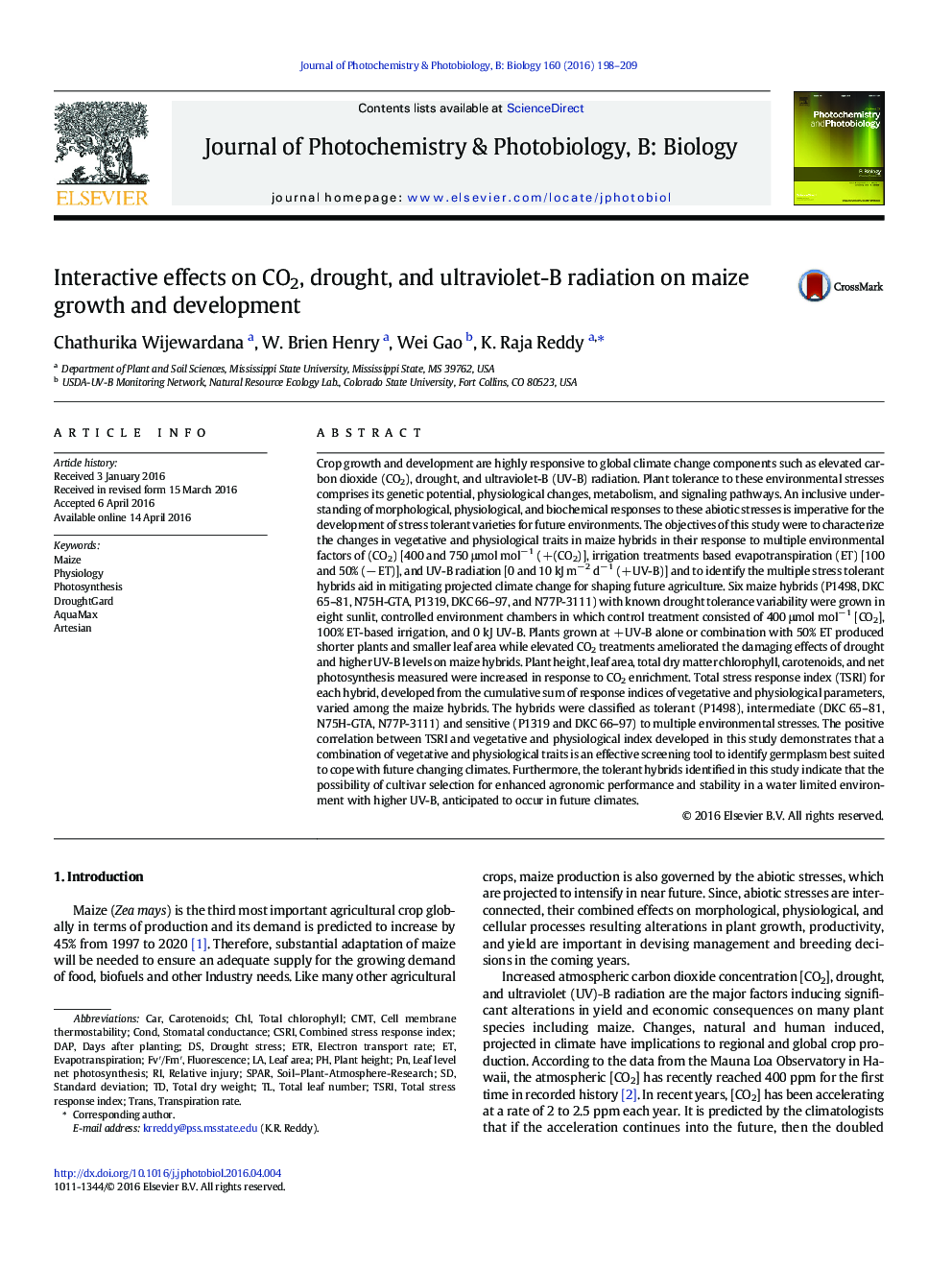| کد مقاله | کد نشریه | سال انتشار | مقاله انگلیسی | نسخه تمام متن |
|---|---|---|---|---|
| 29581 | 44422 | 2016 | 12 صفحه PDF | دانلود رایگان |

• Multiple environmental stress effects on maize morphology and physiology were studied.
• Drought and increased UV-B had negative impact on maize hybrids traits.
• Elevated CO2 compensated the detrimental effects of drought and UV-B stresses.
• Multiple stress tolerant hybrids aid in mitigating climate change.
• Different mechanisms were involved in adaptation or escaping stress tolerance.
Crop growth and development are highly responsive to global climate change components such as elevated carbon dioxide (CO2), drought, and ultraviolet-B (UV-B) radiation. Plant tolerance to these environmental stresses comprises its genetic potential, physiological changes, metabolism, and signaling pathways. An inclusive understanding of morphological, physiological, and biochemical responses to these abiotic stresses is imperative for the development of stress tolerant varieties for future environments. The objectives of this study were to characterize the changes in vegetative and physiological traits in maize hybrids in their response to multiple environmental factors of (CO2) [400 and 750 μmol mol− 1 (+(CO2)], irrigation treatments based evapotranspiration (ET) [100 and 50% (− ET)], and UV-B radiation [0 and 10 kJ m− 2 d− 1 (+ UV-B)] and to identify the multiple stress tolerant hybrids aid in mitigating projected climate change for shaping future agriculture. Six maize hybrids (P1498, DKC 65–81, N75H-GTA, P1319, DKC 66–97, and N77P-3111) with known drought tolerance variability were grown in eight sunlit, controlled environment chambers in which control treatment consisted of 400 μmol mol− 1 [CO2], 100% ET-based irrigation, and 0 kJ UV-B. Plants grown at + UV-B alone or combination with 50% ET produced shorter plants and smaller leaf area while elevated CO2 treatments ameliorated the damaging effects of drought and higher UV-B levels on maize hybrids. Plant height, leaf area, total dry matter chlorophyll, carotenoids, and net photosynthesis measured were increased in response to CO2 enrichment. Total stress response index (TSRI) for each hybrid, developed from the cumulative sum of response indices of vegetative and physiological parameters, varied among the maize hybrids. The hybrids were classified as tolerant (P1498), intermediate (DKC 65–81, N75H-GTA, N77P-3111) and sensitive (P1319 and DKC 66–97) to multiple environmental stresses. The positive correlation between TSRI and vegetative and physiological index developed in this study demonstrates that a combination of vegetative and physiological traits is an effective screening tool to identify germplasm best suited to cope with future changing climates. Furthermore, the tolerant hybrids identified in this study indicate that the possibility of cultivar selection for enhanced agronomic performance and stability in a water limited environment with higher UV-B, anticipated to occur in future climates.
Journal: Journal of Photochemistry and Photobiology B: Biology - Volume 160, July 2016, Pages 198–209